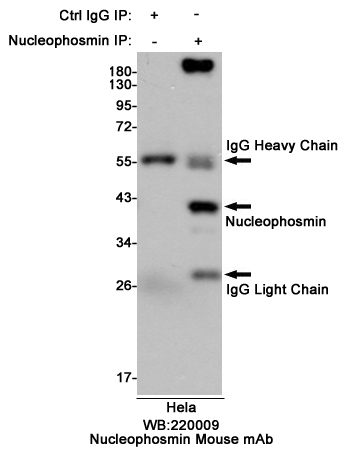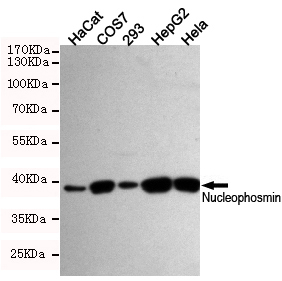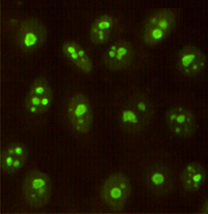-
Product Name
Anti-Nucleophosmin (7H10) Mouse antibody
- Documents
-
Description
Nucleophosmin (7H10) Mouse monoclonal antibody
-
Tested applications
WB, IHC-P, ICC/IF, IP
-
Species reactivity
Human, Monkey
-
Isotype
Mouse IgG1
-
Preparation
Antigen: Purified recombinant fragment of human NPM (2-265) expressed in E. Coli.
-
Clonality
Monoclonal
-
Formulation
Ascitic fluid containing 0.03% sodium azide.
-
Storage instructions
Store at 4°C short term. Store at -20°C long term. Avoid freeze / thaw cycle.
-
Applications
WB: 1/500 - 1/2000
IHC: 1/200 - 1/1000
ICC: 1/200 - 1/1000
ELISA: 1/10000
-
Validations

Immunoprecipitation analysis of Hela cell lysates using Nucleophosmin mouse mAb.

Western blot detection of Nucleophosmin in HaCat,COS7,293,HepG2 and Hela cell lysates using NPM1 mouse mAb (dilution 1:500).Predicted band size:33 Kda.Observed band size:38KDa.

Immunocytochemistry of HeLa cells using Nucleophosmin mouse mAb (dilution 1:100).
-
Background
Swiss-Prot Acc.P06748.Nucleophosmin (NPM), also named B23 or NO38, is a major nucleolar protein which is 20 times more abundant in tumor or proliferating cells than in normal resting cells. NPM has been implicated in several distinct cellular functions, including assembly and transport of ribosomes, cytoplasmic/nuclear trafficking, regulation of DNA polymerase alpha activity, centrosome duplication and molecular chaperoning activities. The NPM is also known for its fusion with the anaplastic lymphoma kinase (ALK) receptor tyrosine kinase. The NPM portion contributes to transformation by providing a dimerization domain, which results in activation of the fused kinase.
Related Products / Services
Please note: All products are "FOR RESEARCH USE ONLY AND ARE NOT INTENDED FOR DIAGNOSTIC OR THERAPEUTIC USE"
